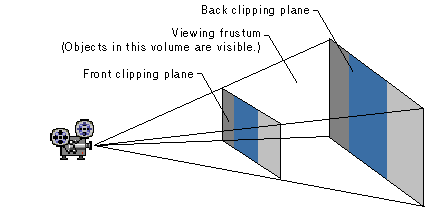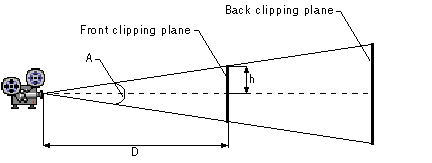
The viewing frustum is a 3-D volume in a scene positioned relative to the viewport's camera. For perspective viewing, the camera is positioned at the tip of an imaginary pyramid. This pyramid is intersected by two clipping planes, the front clipping plane and the back clipping plane. The volume in the pyramid between the front and back clipping planes is the viewing frustum. Only objects in the viewing frustum are visible.

The z-axis of the camera runs from the tip of the pyramid to the center of the back clipping plane. Your application can set and retrieve the positions of the front and back clipping planes by using the IDirect3DRMViewport::SetFront, IDirect3DRMViewport::SetBack, IDirect3DRMViewport::GetFront, and IDirect3DRMViewport::GetBack methods.
The dimensions of the viewport on the front clipping plane determine the apparent focal length of the camera's lens. (You can also think of this as a way to set the magnification of objects in the frustum.) To set and retrieve proportional dimensions for the viewport on the front clipping plane, use the IDirect3DRMViewport::SetField and IDirect3DRMViewport::GetField methods. To set and retrieve arbitrary dimensions for the viewport on the front clipping plane, use the IDirect3DRMViewport::SetPlane and IDirect3DRMViewport::GetPlane methods.
You can use the following equation to determine the relationship between the height (or width) of the front clipping plane and the viewing angle:

In this formula, the viewing angle is A, the front clipping plane is a distance D from the camera, and the height or width of the front clipping plane is 2h. If the device is not square, and thus the clipping planes are not square, the viewing angle is calculated using half the height or half the width of the front clipping plane, whichever is larger. The scale factors are set to the major axis of the device so you don't get distorted objects. If this is not what you want, you need to set uniform scaling.

The viewing frustum is a pyramid only for perspective viewing. For orthographic viewing, the viewing frustum is cuboid. These viewing types (or projection types) are defined by the D3DRMPROJECTIONTYPE enumerated type and used by the IDirect3DRMViewport::GetProjection and IDirect3DRMViewport::SetProjection methods.